The Alphacool Eisbaer 240 CPU AIO Liquid Cooler Review
by E. Fylladitakis on August 1, 2016 9:00 AM EST- Posted in
- Cases/Cooling/PSUs
- AIO
- Water Cooling
- Cooler
- Alphacool
The Alphacool Eisbaer 240 CPU Liquid Cooler
Even though the radiator of the Eisbaer strongly resembles the radiators of many other AIO liquid coolers, the rest of the assembly is unique compared to any other that we have seen up to this date. To begin with, while the Eisbaer is upplied assembled and prefilled but it actually is a standard liquid cooling kit, as the tubing is not permanently attached on either the radiator or the block/pump assembly. Typical tubing compression fittings are used on both parts that can be undone at any time by the user.
The glossy black tubing of Eisbaer appears to be made out of PVC and has an internal diameter of 11 mm, which is much more than sufficient for a simple system with just one block. A black spring surrounds the glossy black tubing, preventing it from kinking when taking sharp turns. Alphacool also included a plastic connector on one of the tubes, offering the option of relatively quick future upgrades.
The radiator of the Eisbaer may be visually almost identical with the radiators used by many other products. A closer inspection however reveals a major difference: both the channels and the fins of this radiator are made out of copper. This makes the radiator a little heavier and considerably more expensive to manufacture, but it should also offer a noteworthy performance boost. The company logo can be seen printed on the sides of the steel frame.
Eisbaer’s block/pump assembly is quite tall but not very wide, with a plastic body and a copper base. There is a fill tap on the top of the assembly, allowing the user to refill and maintain the system. The company’s logo has LED lights installed and will illuminate blue once the pump is powered on. A little window on the side reveals the pump and fluid to the user. As this would not be visible from the side panel of the case, Alphacool did not install LEDs inside the block.
Inside the assembly we can see one of Alphacool’s pump designs based on the DC-LT Ceramic 12V pumps. The maximum flow is 70 L/h and it has a head of 0.85 m, figures that may not be great compared to those of large external pumps, yet are impressive for such a small device.
The copper base of the cooler is very smooth and appears to have been machined down to a perfect mirror finish. Unfortunately, copper is very easily oxidized and we received one of the pre-production samples that only had a temporary protective sticker attached. It was not attached well and the trapped air oxidized the base of our sample, creating an abstract canvas. This cannot and will not affect the performance of the cooler in any way, it is a mere aesthetic mishap that degrades the appearance of the product.


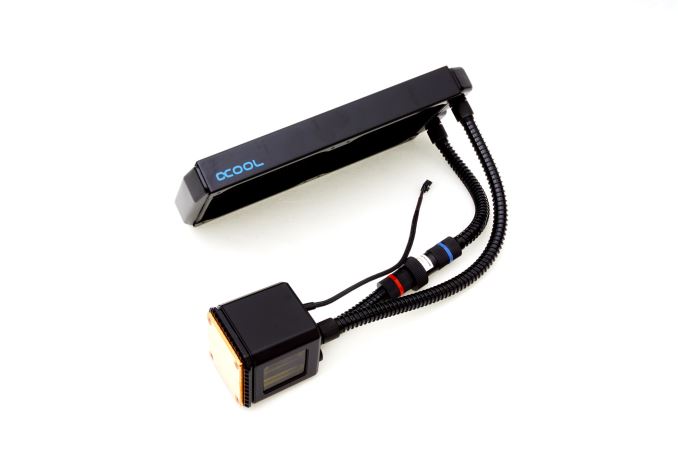
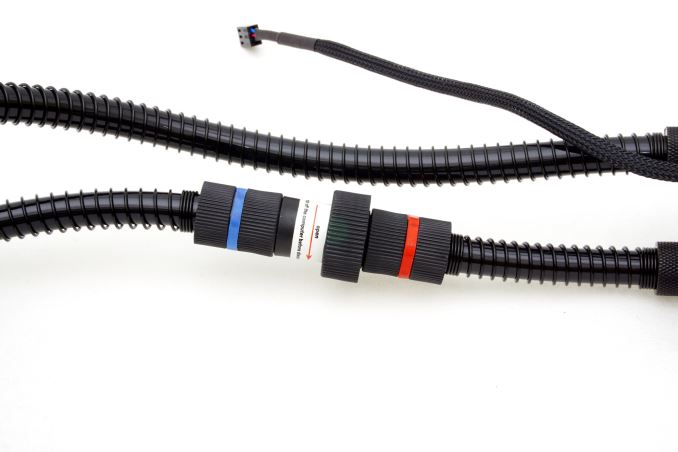
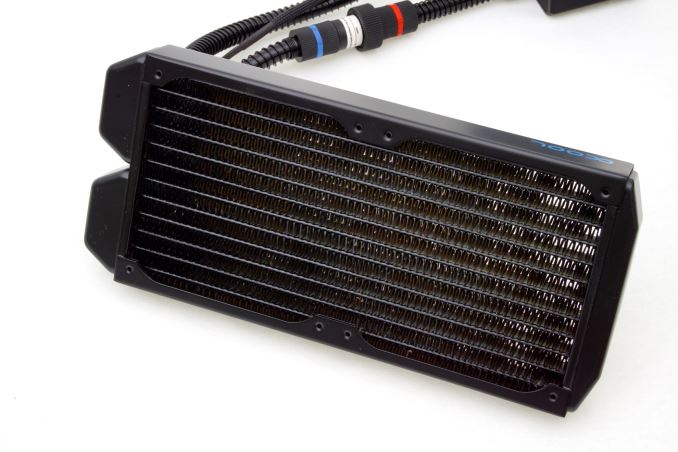
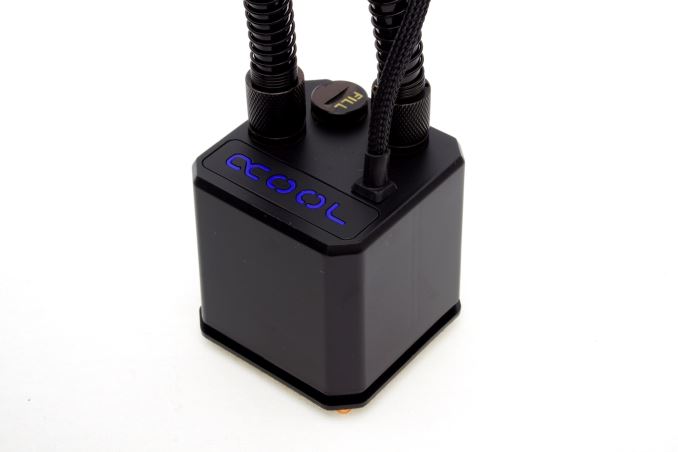
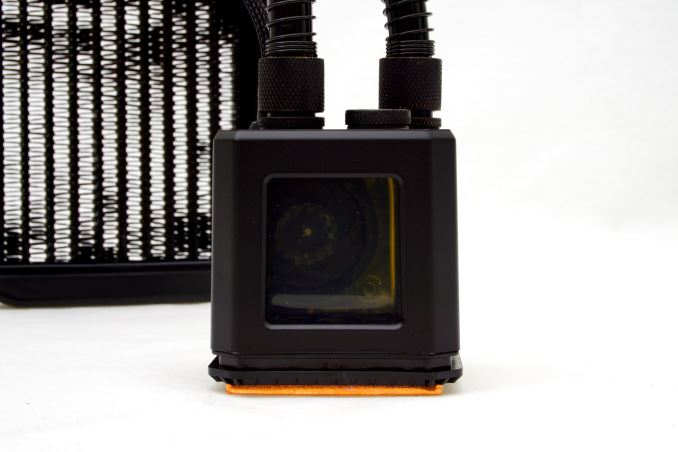









69 Comments
View All Comments
Sushisamurai - Sunday, August 7, 2016 - link
I think mainstream computers/CPU's don't need liquid, at all. If you're running an enthusiast build/HEDT then I think it's almost necessary. My CPU draws almost 230W at full load - I didn't bother putting an air cooler for noise issues.rhysiam - Monday, August 1, 2016 - link
"I personally think that air coolers have reached their EOL. There is no need for a big chunk of metal to sit on top of your motherboard especially when nowadays you can buy an excellent AIO that is reasonably priced, quiet, cools better, and looks aesthetically more pleasing, and its painless to install"I can't agree with you at all on this. If we consider the three key metrics we can quantify being price, noise and thermal performance; air coolers objectively beat AIO water coolers by a significant margin. Entry level water coolers like the H60 are more expensive, hotter and louder than a wide range of air coolers, and perform terribly compared to similarly priced air towers (H60 prices take you into mid-range air cooler territory). Once you move up a tier to high end air coolers like the NH-D15, you need to spend far more money to get a similarly performing AIO. There are 240mm closed loop water coolers that appear to offer superior thermals for close to the $100 mark, but they do so by using hair-dryer like fans. If you want D15 performance from water and care at all about noise levels, you need to be prepared to spend a lot of money.
There are absolutely benefits to AIO water coolers: stress-free portability, RAM compatibility and potential to use in smaller cases. But, if you care primarily about getting the highest performing and quietest CPU cooler for your dollar, air still wins every time.
Hxx - Tuesday, August 2, 2016 - link
I bought an H55 for $25, an H110 for $55, and H100i gtx for $75, a thermaltake water 2.0 performer for $20, a thermaltake 240mm water 2.0 for about $50...over the past 4 or so years. Yes not everyday prices, but newegg sales, microcenter open boxes, etc. Like I said, no need for an air cooler anymore. Corsair even goes as far as covering your components if your cooler for whatever reason breaks and takes some other components with it.The latest cooler I bought is the corsair h100i gtx for $75. My overclocked core i7 4770k 4.6ghz sits at 25C and 40ish when gaming in a corsair air 240 case. The pump is in "quiet mode". I can't hear the fans or the pump so I m happy. Also $75 is not a lot of money for a CPU cooler when a high end air cooler is almost just as much.
ikjadoon - Tuesday, August 2, 2016 - link
Wrong. You need to update to Gen5 Asetek.http://www.hardocp.com/article/2016/02/11/arctic_c...
$25 cheaper than the NH-D15, quieter than the NH-U14S, and 5C cooler than the NH-U14S.
Keep up with reviews, dude.
rhysiam - Wednesday, August 3, 2016 - link
So this Eteknix review paints quite a different picture of that cooler you linked: http://www.eteknix.com/arctic-liquid-freezer-120-a...A full 14 degrees hotter than the D15 on an OC'd CPU (3570K) at 1.35V. Acoustics are still great, but temps, while fine, are hardly world beating. In fact they suggest 1.35V on an i5 is asking a bit too much of this 120mm cooler.
My issue with the HardOCP review is that the biggest load they put that cooler under is a 4.4Ghz OC on a 4770K at a measly 1.25V. That's just not enough to push any half decent cooler. Obviously it's got a great price and is really quiet, so would be a good choice for lots of people looking for a mild OC, but if all you want is a 1.25V mild OC, another valid option would be a cheap air cooler for $25?
I'm not saying AIO coolers don't have a place, clearly they do. But to say they make air coolers "EOL" is just not accurate IMHO.
Also, maybe ditch the BM next time? I expect better from comments here at Anandtech.
letmepicyou - Monday, August 1, 2016 - link
What you're missing about water cooling might be the fact that water cooling setups are WAY more convenient than some of the better air solutions out there. I can show you a nook in my one cupboard where I have some of the best air coolers around (Tuniq Tower, Antec CNPS 10X, Thermalright Silver Arrow, the list goes on). The problem with air? First is the weight it puts on the motherboard (which is a particular concern if you move your computer regularly). Second is the fact many high-end air coolers interfere with the ram slots, depending on the cooler / motherboard combo you happen to be using, and whether or not your ram happens to have taller than average heat sinks.The perfect solution? An AIW water cooling setup. There is no motherboard stress worth mentioning, and I have GOBS of clearance for literally any ram I choose to use, regardless of where or how it's oriented on the board. I have a pretty stout system (i7 4790k, stock clocks) but it's not always about overclocking ability or raw cooling potential, sometimes it's about pure logistics.
rhysiam - Tuesday, August 2, 2016 - link
While water may be more convenient, it's also more expensive for a similar performance tier. And it's not like low profile RAM is hard to find or has any real drawbacks. Air certainly puts more weight on the motherboard, but it doesn't introduce liquid to the system. So while water is likely safer for a portable system, I'd suggest air is the safer bet for a static PC.Clearly you'd prefer to spend more or sacrifice cooling performance for system portability and RAM compatibility... that's fine, there's heaps of situations where that's the right call. But there's undoubtedly a place on the market for the superior performance per dollar that air coolers offer.
retrospooty - Tuesday, August 2, 2016 - link
" Second is the fact many high-end air coolers interfere with the ram slots, depending on the cooler / motherboard combo you happen to be using"- You may have a point if you are upgrading an older system and therefore stuck with particular existing parts, but if you are building a new system you can build a better cooled system for cheaper with a good air cooler.
zodiacfml - Tuesday, August 2, 2016 - link
That gave me an idea for a future build. I guess, water cooling should be focusing on graphics these days.ikjadoon - Tuesday, August 2, 2016 - link
Yup. I'm slapping this AIO CLC on my next GPU: cheaper than NH-U14S, cooler than a NH-U14S, and quieter than a NH-U14S--all at the same time! :DThe reign of air coolers is about to end with Gen5 Asetek.
http://www.hardocp.com/article/2016/02/11/arctic_c...